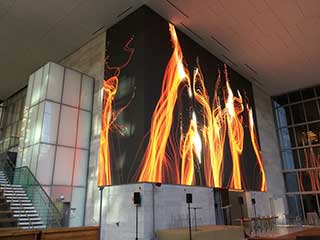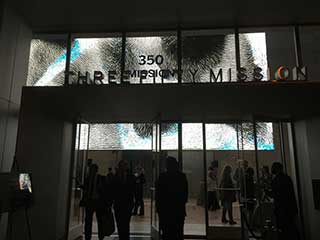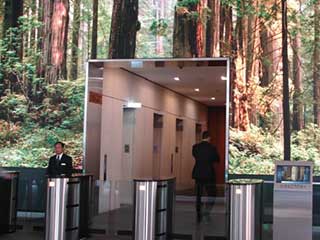LED Video Walls Emerging within the Urban Landscape
For further coverage of LED video walls, please visit:
- NPR's Voice Incorporates LED Displays As Part of Its New Look
- Corporate Lobbies: The New landscape of Digital Signage
 350 Mission 6 mm LED Screen Video Wall
350 Mission 6 mm LED Screen Video WallWithin the ever changing urban landscape of San Francisco, the recent addition of two lobby LED video walls are redefining the architectural presence of public space in its downtown financial district. The video walls with their elegant visual content are presenting an artistic commentary of the social and environmental dynamic forces that swirl around San Francisco.
The first building incorporating an LED video wall, located at 350 Mission Street is a recently erected Class-A 30-story skyscraper which was established by real estate developer Kilroy Realty Corporation (San Francisco) and architects Skidmore, Ownings & Merril (SF) who described the building's lobby, "as a vibrant space that blurs the boundaries between public and private realms."
350 Mission which is the building's name as well its downtown address has redefined ground level public space by designing the building lobby to be as much an art gallery as it is a passageway to the building's elevators and dining area.
Sensory Interactive Initiates Lobby Video Wall
To manage the complexities of defining the parameters of the LED lobby wall and ensuring successful integration of the art content for the display, Kilroy Realty engaged Sensory Interactive (Baltimore, Maryland) to lead the effort of coordinating the video wall's design, integration, procurement, fabrication and installation through completion.
Sensory Interactive's President and CEO, Randy Byrd ensured his multi-disciplinary team continued the video wall's development by further defining the programming schedule and ensuring the day-to-day operational services in bringing the building's lobby to life as a dynamic public space with impactful visual content.
The integration of dynamic video walls into building lobbies has taken architectural enhancement to the next level. Here the lobby is more than a mere passage way, it is a media space and an art gallery, in effect transforming the space into a cultural and active experience.
The 350 Mission Street's lobby space includes a 50-foot high ceiling and glass facade creating a visually inviting open space for tenants, passersby and nearby vehicular traffic. Developer Kilroy Realty sought out the video display as an important part of the building's presence at street level.
Nicole Stromsness, Kilroy's Construction Project Manager noted that, "having the video wall in the lobby adds value to the building, making it a unique public destination in its own right." On sunny days in San Francisco's financial district, the viewing experience is expanded by the lobby's glass facade folding back to present an unobstructed view of the display screen.
350 Mission and the Sansi Video Wall
The LED screen manufactured by Sansi North America (New York) hugs the lobby wall and wraps around a sharp corner with an extended display mounted on the lobby sidewall. The video display, which features surface-mount device (SMD) pixel packaging technology 5 and a 6 mm pixel pitch, is composed of S|Video LED modules, each 9.4-inches x 9.4-inches (240 mm x 240 mm) and incorporates a total of 4,176 LED modules. The LED video display is approximately 68-feet long and 37-feet high, offering 2,643 square feet of video canvas.
 350 Mission LED Display Wall
350 Mission LED Display WallThe assembly of the full LED screen could be likened to a Lego-like process consisting of multiple steel subframes bolted to the lobby wall. Knowing the final size of the video display allowed SNA to determine how many subframes to custom manufacture and assemble into the final video wall steel frame. As discussed by SNA's Jason Helton, Vice President, "The video wall's steel subframes acted as anchor points for the final video display.
The LED modules were assembled into larger sign cabinets, which included the requisite power supplies and logic boards. The sign cabinets were then assembled into custom-fabricated subframes, which were delivered to the project site and then picked and placed on the lobby wall.”
Custom Corner Completes Screen
The display was design so that its content would flow seamlessly from the front screen to the sidewall screen. Helton noted that because the 350 Mission video screen had a requirement for a seamless screen, SNA fabricated a series of custom corner cabinets for the project.
"In assembling the full LED screen which consists of an asymmetrical design with its one main screen and a much shorter adjacent sidewall screen," stated Helton, "a series of custom corner cabinets were mounted first where the two walls converge. Once the custom corner was in place, it was followed by the installation of the left and right side LED sign cabinets to both sides of the corner. The completion of each row began the assembly of the next row until the entire steel frame was fully covered with its video wall display."
In its final form, the SNA interior video wall can present its content in any number of animations, videos, graphic imagery or live data simultaneously. Given that the 350 Mission video wall is a dedicated digital art canvas, its all encompassing visibility has already made an impact within its surrounding neighborhood. The LED display is large enough and fully visible behind its glass facade that it is easily viewed by those walking or driving past it. Passersby have been known to enter the lobby (which is encouraged) and watch contemplatively as its display content continuously evolves within its presentation.
Virtual Depictions: San Francisco
The 350 Mission video artwork, Virtual Depictions: San Francisco was commissioned by Kilroy and created by Refik Anadol, who is a media artist exploring the convergence of interactive media and architecture. Anadol is also an instructor and visiting scholar for the Design Media Arts Department at the University of California Los Angeles (UCLA). Anadol noted that the creation of Virtual Depictions is site specific and designed to conform to the space where it is exhibited. Thus the same digital exhibit could appear differently in different spaces.
350 Mission video artwork, Virtual Depictions
The significance of Virtual Depictions is that it's not a static artwork or an abstract graphic or a slideshow of amazing fantastic realism landscapes. Virtual Depictions is a living, breathing data sculpture that as Anadol notes, "is driven by specific segments of information or data sets that are constantly transforming the displays images and creating what he describes as “data sculptures.”
The data that drives the sculptures come from the city's ambient surroundings including Environmental, Social Media and Post-Architectural influences." Anadol's data sculptures are defined by the use of parametric analytics which is a design process that creates a visual relationship between the data it is measuring and the visualization that represents the data.
These interactions that swirl around the city are captured by Virtual Depiction’s data engines and form a continuous data sculpture that presents its data visualizations as an art experience. People are so awed by its potential noted Anadol that they are visiting Virtual Depictions from all over the Bay Area to see and connect with its interpretative visualization of San Francisco's interactive communications.”
DeeDee Postil, Kilroy's art curator noted that because the content is in a real-time relationship with all the data that shapes its visualizations, it is always changing, and what viewers see as they watch Virtual Depictions may not be the same in their second visit to the display. Already it has earned the SEGD Global Design Award.
50 Fremont Splashing Waterfall
 50 Fremont 4 mm LED Screen Video Wall
50 Fremont 4 mm LED Screen Video WallIn a neighboring skyscraper, 50 Fremont, which is directly across the street from 350 Mission, yet another LED video display was installed. This LED video wall was also coordinated by Sensory Interactive and its screen also supplied by SNA. This other video wall also employed SMD S|Video LED tiles, but with a tighter, high density pitch (4 mm) and equally sharp resolution as its neighboring 350 Mission screen. The 50 Fremont LED video wall display is also noted at 12-feet high and 106-feet long to be the longest continuous 4 mm pitch screen in the United States.
The architectural design for the 50 Fremont video wall was challenged by its three elevator bay entrances as part of the lobby wall. In its final design the video wall simply covered the entire lobby wall offering an unusual expressive visual look, in both its content and how it was presented. Rather than displaying interactive software, the 50 Fremont screen relied on a series of nature-based landscapes composed and composited with a collaboration between two world-class video effect companies, Obscura Digital (S.F. CA) and Fusion CI Studios (L.A. CA).
Described by Fusion CI's video FX supervisor, Mark Stesiuk, he noted, “...it would be spectacular to bring the enormous expressions of nature into 50 Fremont's minimalist, hard-edged lobby.” From this inspiration, the companies collaborated a series of nature-based landscapes, such as a full landscape of Muir Woods, a nearby wilderness destination landmark. Another lobby wall landscape which has been popularly documented is a realistically fantastic scene of a waterfall with its runoff splashing over and around each of the elevator bay entrances.
The waterfall spillage is realistic enough that standing in the lobby watching it, you expect at any moment to get splashed by the spillage. Several smartphone users have videoed the waterfall and posted it on YouTube and Vimeo where it has gone viral with many reposts and shares on multiple social networks, accumulating millions of views” so far. The 50 Fremont video wall was installed by Arrow Sign (Oakland, CA).
50 Fremont 4 mm LED Video Wall
“The appreciation for both San Francisco lobby video walls has been incredible. The content of both lobby video walls has been posted on-line and have gone viral through the social media circuits,” stated Byrd. It's also become a big hit with architects and developers around the country that Byrd has talked with as he noted that both lobby video walls “have become the source of inspiration for them and their clients in the way they are looking for new design solutions in their upcoming new building lobbies.”
Digital Canvas and Public Space
The integration of artistic video walls in lobbies merges architecture and digital media into a new realm of pedestrian interactions. Lobbies are transformed into dynamic art galleries and for those passing through into or from a work environment it creates a moment of pause to contemplate an art experience they might not otherwise encounter.
San Francisco's efforts in opening up its building lobbies to the digital domain could very well become a trend where architects, developers, LED manufacturers and sign installers all share in redefining architectural public space as a digital canvas for cultural and communal experiences inside buildings as much as they're also found on building exteriors.





